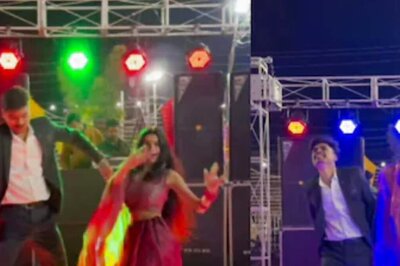
views
The Honda Jazz is the most desirable hatchback in India and there’s no disputing that. We’ve liked its space, its versatility, its interiors, its engine - heck everything about the car - except its pricing. Two years ago on our mega hatchback comparo in Ladakh the Jazz stood head and shoulders above its brethren yet it couldn’t win the test because of its silly pricing.
Finally the pricing issue has been addressed with this refreshed Jazz. What’s new? There are new bumpers, new grille, new headlamps and new colors, all of which amounts to not very much. The main thing is the pricing which has come down a whopping Rs 1.6 lakh with the base variant now at Rs 5.50 lakh going up to Rs 6.06 lakh. And with that came a flood of e-mails and calls: is the new Jazz the best hatch in the country?
No better way to answer the question than to pit it against the winner of last month’s mega hatchback test to the North East - the new Swift. The Swift has been the best car in its segment since it was launched all those years ago and now the all-new Swift (looks like a mild refresh but it really is all-new) raises the bar yet again. The moot question is has the bar been raised over the Jazz?
Styling
The Swift was always an attractive car but with the new one Suzuki hasn’t moved the game forward and the very close resemblance to the older generation doesn’t make the car stand out. Look closely, or better still stand it against an old Swift, and you will notice the new headlamps and taillamps and that in profile the nose looks longer but you do have to look closely. What you will also notice is the ride height has been jacked up for Indian roads and it leaves a lot of daylight between the tyres and wheel arches which is possibly the only sore point in an otherwise extremely well-executed design.
The Jazz though gets my vote on the styling front and is that wee bit more eye-catching than the Swift; the fact that you hardly see a Jazz on the road while Swifts are aplenty helps the Honda’s case immensely. The revised nose (which keeps in step with the facelift done to the international model) does make the car sportier in appearance and the big change you will notice is the hexagonal shape to the grille with the Honda logo perched inside it.
This is a Honda family signature which is also sported by the Brio (though being fully chromed kind of loses the plot) and will also be seen on next month’s revised Honda City. The headlamps have also been subtly altered and the top edges have become more curvy while the reflectors inside are also new.
The new front bumper has raised vertical slashes originating from the headlamps and flowing down to frame the air dam while the fog lamps also get raised surrounds. It all adds up to give the Jazz a fresher and more modern look; even a hint of visual aggression.
The rear bumper is also revised with a strongly defined lip and even a mock diffuser to add to the sporty look. The taillamps, profile and everything else are exactly the same.
Interiors
The interiors too are identical and there was nothing really wrong with that, it was (and still is) the most practically and ergonomically designed cabin in its class. Cup holders (ten of them!) and cubby holes are dime a dozen, there are two glove boxes, the steering wheel (from the Civic) is stylish and great to hold, the stereo now gets a USB input (and it also takes CDs unlike the Brio and City), the seats get two-tone upholstery and space inside is just incredible.
Despite the Jazz being just 10mm longer than the Swift (the two are similarly wide), the Honda delivers almost as much space as a bigger C-segment car. The Swift has grown by 90mm in wheelbase over the old Swift and Maruti claim rear seat space has improved by 20mm all of which makes for a comfortable cabin with adequate space. But the Jazz just demolishes it on spaciousness with more head, leg, knee and shoulder room.
Even with a six-footer sitting up front there is an abundance of knee room at the rear and since the Jazz adopts an MPV-ish profile there is acres of headroom across the cabin. The windscreen is much further away from the steering wheel (like an MPV) and the dash goes on for longer in front of you - this along with a quarter glass in the (narrow) A-pillar does a great job in enhancing the feeling of space and airiness.
The seats are also more very comfortable in the Jazz (though the Swift is equally supportive and accommodating at the front) and at the rear three can sit abreast without resorting to elbow fights. This is the best example of Honda’s ‘man maximum - machine minimum’ philosophy which is also visible in the Brio though there the ‘slenderisation’ term has been employed.
Not only is there tonnes of space in the Jazz but versatility is also top notch. The rear seats fold flat into the floor to deliver a fully flat loading bay increasing boot space from 384 to a whopping 1320 litres. The seat squab can also be raised to use the foot wells for loading tallish cargo (like potted plants), something the Swift (or any other hatch for that matter) cannot do.
The Swift may have grown in size but boot space has reduced by 21 litres to 211 litres and the higher loading lip makes throwing in bags more difficult. However in outright stylishness the Swift’s cabin gets my vote. This is an all-new interior and majors on style and equipment; thankful Maruti have resisted the temptation to swathe it in beige and the predominantly black hues make it look very sporty and inviting.
In terms of equipment the Swift and Jazz are on par, with only climate control missing in the Honda but where the Jazz offers ABS and airbags on all models, the Swift only offers on the ZXi.
Engines
No change here with the Jazz retaining the excellent 1.2-litre i-VTEC engine that kicks out 88PS of power and 110Nm of torque. We have previously rated this as the best 1.2-litre petrol in the business and allied to the kerb weight of 1060 kilos it gives the Jazz has a power to weight ratio of 84.90PS/ton.
Suzuki however haven’t been resting on their laurels on the powertrain front and have kitted out the excellent 1.2-litre K-Series engine with variable valve timing boosting power to 87PS while torque goes up to 114Nm. The crucial bit is that maximum torque in the Swift comes in at 4000rpm, 800 lower than the Jazz and that gives it greater flexibility and stronger roll-on times. Both engines love to be revved and thrive at the top end of their rev band but the Suzuki has a slightly better bottom end while also boasting of a higher power to weight ratio of 91PS/ton thanks to being 100 kilos lighter.
This makes it quicker too, 0-100kmph coming up 12.93seconds which is over a second quicker than the Jazz’s 14.01 seconds. Top speeds are identical but the Swift is quicker to both the quarter mile and standing kilometre mark and crucially feels more involving. Both cars have utterly delicious gearboxes but if I had to choose I’d take the Swift’s.
The Swift is also our pick on the refinement front and though the Jazz is noiseless at idle once revs pick up it’s a bit noisier than the Swift. That said the refinement of both these cars are significantly better than its rivals and we’re just splitting hairs. In fuel efficiency the Swift scores a decisive lead being over 2kmpl better when you look at the overall figures. In the city both deliver almost identical figures (Jazz - 14.72, Swift - 14.9) but the gap opens up on the highway runs with the Swift delivering 20.1kmpl to the Jazz’s 18.4kmpl.
Dynamics
The all-new platform has seen the Swift grow wider and longer but it hasn’t lost any of its dynamic appeal and is as utterly involving to drive as before with great chassis balance and responsiveness. The switch to 15-inch tyres has worked wonders, delivering both better grip courtesy the new MRF rubber and notably improved ride quality. And the steering is just a delight with great response and feedback. It all makes for a car that is the enthusiasts’ choice delivering more smiles per mile than any hatch in the country.
The Jazz is not far off the Swift’s benchmark with great steering and crisp responses. However understeer and tyre squeal sets in earlier thanks to tyres tuned for fuel efficiency (it is also narrower at 175-section to the Swift’s 185-section). The ride quality is a smidgen better than the Swift though the Suzuki feels a little more solid when pounding poor roads and speeds.
Verdict
At the end it all boils down to pricing. Like-to-like if we compare the top end Jazz X to the Swift ZXi there’s still a significant Rs 53,000 price difference while the difference between the base Swift and the base Jazz is a whopping Rs 1.28 lakh. And that seals the debate in the Swift’s favour.
However things aren’t as cut and dry if you look at equipment levels. The base Swift literally has nothing while the base Jazz has everything on the top end X variant except for alloys and fogs plus airbags and ABS. So if you’re in the market for a premium hatchback what will be left on your plate is the top-end Swift ZXi and the base Jazz and the price difference between the two is Rs 3000 - in the Jazz’s favor.
Sure the Jazz lacks the Swift’s alloys, fogs and climate control but really that can’t swing the verdict. What does matter is space, practicality, desirability, driving pleasure and a sense of being in a premium hatch and on all those fronts the Jazz noses ahead, particularly on the spaciousness front that is its main USP.
The Swift might still be the enthusiasts’ choice but the blend of talents and abilities ensures the Jazz is still the best hatchback in the country. And finally it is priced sensibly enough to win this comparison test.




















Comments
0 comment